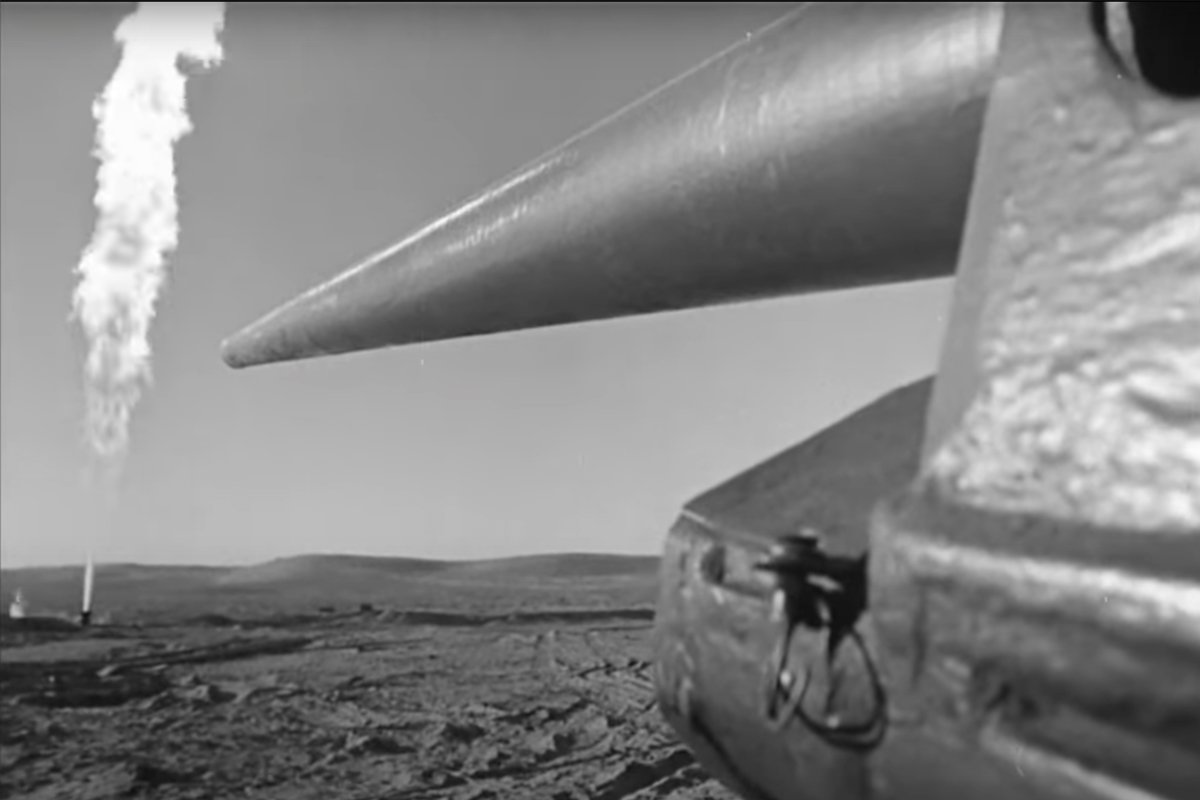WATCH: That Time the Soviet Union Put Out a Gas Fire With a Nuclear Explosion

A Russian Army field artillery emplacement takes aim at the wellhead of gas well No. 11 in Uzbekistan during a tactical operation to help firefighters extinguish the flames. This effort came before all options were exhausted and a nuclear weapon was detonated underground. Screenshot via YouTube.
In a remote desert in Uzbekistan during the 1960s, an endless stream of flames spewed into the air over the Urta-Bulak gas field for 1,064 straight days. Soviet efforts to extinguish the out-of-control blaze simply exacerbated problems for the firefighters on the ground.
After conventional firefighting techniques had failed, the only remaining way to extinguish this gas-fueled hellfire, at least according to Soviet officials, was to kill it with a nuclear explosion.
The disastrous fire began on the night of Dec. 1, 1963.
After several drilling procedures were ignored, gas well No. 11, drilled to the depth of 2,409 meters (1.5 miles), opened up a thick, gas-bearing formation with 300 atmospheres of pressure. The underground pressure created a gas blowout that destroyed the well’s steel rigging structure. A powerful column of burning fuel shot 120 meters (about 400 feet) high. While crews employed tractors to successfully remove the well’s framing, the fire became unmanageable.
“The flame of the candle consumed more than 12 million cubic meters of gas every single day, which exceeds the daily needs of a large city like Leningrad,” says the narrator of a Russian film about the blaze.
(Enable closed captions for English subtitles for the video below.)
In order to extinguish the inferno, firefighters first proposed the installation of a cap with a special pressure relief feature. In theory, with the lid in place, the gas flow would divert to other discharge pipes, lessening the pressure.
The partially applied cap served as a small victory in January 1964. However, the fix didn’t last long. Numerous craters rich in sulfide emerged through the ground and emitted toxic fumes, further polluting the air.
Despite using Russian field artillery, water cannons, and prodigious engineering ingenuity, the Soviets’ efforts backfired. The industrial nightmare persisted until the summer of 1966. By that time, Soviet officials employed specially designed rigs to explore the possibility of an underground nuclear detonation. Experts ensured the safety of civilians, some of whom were located as close as 27 kilometers (17 miles) away from ground zero.
The highly complicated plan was given the green light, and the Soviets executed the first-ever peaceful nuclear explosion to quell a gas fire.
“On that cold autumn day in 1966, an underground tremor of unprecedented force shook [the observers] with a sparse grass cover on white sand,” The New York Times quoted from a Soviet newspaper in 1971. “A dusty haze rose over the desert. The orange-colored torch of the blazing well diminished, first slowly, then more rapidly, until it flickered and finally died out. For the first time in 1,064 days, quiet descended on the area. The jetlike roar of the gas well had been silenced.”
Read Next: Why the US Navy Annihilated Its Own Battleships With Atomic Bombs

Matt Fratus is a history staff writer for Coffee or Die. He prides himself on uncovering the most fascinating tales of history by sharing them through any means of engaging storytelling. He writes for his micro-blog @LateNightHistory on Instagram, where he shares the story behind the image. He is also the host of the Late Night History podcast. When not writing about history, Matt enjoys volunteering for One More Wave and rooting for Boston sports teams.
BRCC and Bad Moon Print Press team up for an exclusive, limited-edition T-shirt design!
BRCC partners with Team Room Design for an exclusive T-shirt release!
Thirty Seconds Out has partnered with BRCC for an exclusive shirt design invoking the God of Winter.
Lucas O'Hara of Grizzly Forge has teamed up with BRCC for a badass, exclusive Shirt Club T-shirt design featuring his most popular knife and tiomahawk.
Coffee or Die sits down with one of the graphic designers behind Black Rifle Coffee's signature look and vibe.
Biden will award the Medal of Honor to a Vietnam War Army helicopter pilot who risked his life to save a reconnaissance team from almost certain death.
Ever wonder how much Jack Mandaville would f*ck sh*t up if he went back in time? The American Revolution didn't even see him coming.
A nearly 200-year-old West Point time capsule that at first appeared to yield little more than dust contains hidden treasure, the US Military Academy said.












